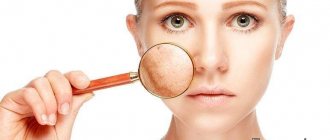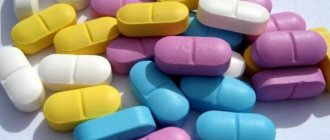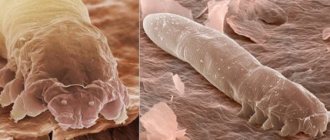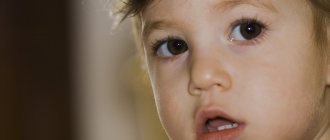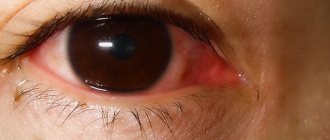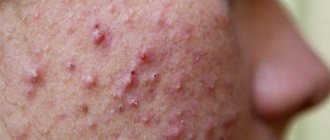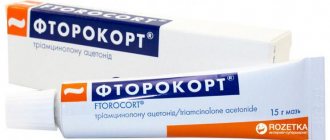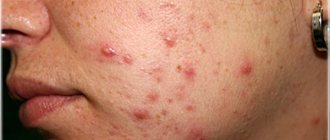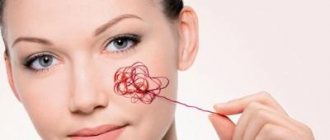Rosacea (or, as they are also called, rosacea) is a facial skin disease that occurs in a chronic form with relapses, characterized by damage to the sebaceous glands, hair follicles and skin capillaries. The disease is one of the most common in dermatological practice: according to medical statistics, it affects about 10% of patients. Most often it affects fair-skinned people, in particular women over the age of thirty.
The dermatovenereology department of CELT offers a course of treatment for rosacea in Moscow. Our clinic has been operating in the paid medical services market for almost 30 years and has a powerful diagnostic and treatment base. Thanks to it, our specialists are able to accurately diagnose and individually select treatment that will be carried out in accordance with modern international standards.
At CELT you can consult a dermatologist.
- Initial consultation – 3,200
- Repeated consultation – 2,000
Make an appointment
Etiology of rosacea
Experts identify a number of factors that initiate the development of acne. Most often this is severe overheating or, on the contrary, hypothermia of the skin, as well as:
- Exposure to sunlight, including in a solarium;
- Frequent stress;
- Local use of glucocorticosteroids;
- The use of harsh scrubs not intended for facial skin;
- Independent use of chemical peeling;
- Bad habits: drinking alcohol and smoking;
- Constant inclusion of too hot and spicy foods in the diet.
If the patient has a history of individual intolerance to certain substances, manifested by allergic dermatitis, the risk of developing acne is quite high. It was previously thought that acne could be caused by demodex mites; recent research has found that this is not the case. Their presence in the follicles is not the cause of the development of the disease, but enhances its clinical manifestations.
Based on the method of exposure, it is customary to divide the factors for the development of acne into two groups:
- Exogenous - acting externally, represented by the physical effects of high and low temperatures, insolation, as well as nutritional - hot drinks, spices, etc.;
- Endogenous - gastrointestinal diseases caused by the bacterium Helicobacter pylori, infectious lesions of the skin, diseases of the endocrine system, decreased immunity.
Rosacea Clinic
Clinically, it is customary to distinguish several forms of rosacea:
| Shape of rosacea | Symptoms of acne |
| Ophthalmic | It is represented by a number of pathological conditions affecting the anatomical structures of the eyeball. They are manifested by the following symptoms:
About half of patients with rosacea complain of the above manifestations. |
| Erythematous | Intense limited redness (erythema) appears on the skin of the face, resulting from dilation of blood vessels. They do not disappear and are accompanied by numerous telangiectasia on the cheeks. The latter are a persistent expansion of small vessels in the form of meshes or stars, visible to the naked eye. |
| Papulopustular | Against the background of erythema, whole groups of small papules appear, covered with thin scales. They first affect the skin on the nose and nasolabial folds, and then spread to the forehead and chin. Over time, they partially turn into pustules, i.e. pustules. Skin infiltration and swelling may develop. |
| Phymatous | Acne appears as nodules and plaques that tend to enlarge and coalesce the affected areas. |
Rosacea: what is it and what is dangerous if left untreated?
This is a disease that affects blood vessels and is characterized by redness of the face or certain areas of it. Its appearance leads to a deterioration in appearance due to cosmetic defects, as well as related psychological problems. In addition, rosacea (rosacea) on the face, if the eyes are affected, can cause keratitis and corneal ulceration.
Complications also include:
- thickening of the skin of the chin with the skin acquiring a bluish or burgundy tint (this is extremely rare and appears mainly in men);
- thickening of the earlobe (also rare and can cause hearing loss);
- thickening of the skin of the forehead, which leads to severe asymmetry of the forehead, especially against the background of chronic inflammation and stagnation of blood;
- thickening of the skin of the eyelids, in which the palpebral fissure narrows in the horizontal direction and the upper eyelid droops (causing a feeling of serious discomfort);
- scleritis (inflammation of the sclera of the eye), which is accompanied by pain, blurred vision, and eye irritation; complete loss of vision is possible.
The disease occurs in several stages, and the early form of development is much easier to treat and stop, so at the first signs you should immediately contact a dermatologist
.
How to treat rosacea on the face and can it be cured forever?
Effective, high-quality and long-lasting treatment is possible only under the supervision of a specialist who will determine the cause and stage of the disease and prescribe a course of treatment according to the individual characteristics of the patient (gender, age, clinical picture, etc.).
In very rare cases, the disease can go away on its own, but generally rosacea (rosacea) is a disease that is chronic and can progress with age. This differs from rosacea to acne, which often disappears on its own once you leave adolescence. Therefore, treatment should be such as to increase the time of remission and reduce the frequency of relapses and their duration. Treatment, like prevention, must be comprehensive and, as already mentioned, carried out only under the supervision of a doctor.
Rosacea: symptoms and forms
Main symptoms:
- redness of the facial skin mainly in the T-zone (forehead, nose, chin) and on the cheeks (persistent redness);
- redness may spread to the back and chest;
- the appearance of pink bumps without treatment turns into pustules, acne and pimples;
- the skin on the affected areas thickens;
- profuse lacrimation in the final stages;
- rhinophyma (redness and thickening of the skin in the nose area, most often in men);
- redness, dryness, itching and flaking around the eyes.
There are different definitions of the stages of rosacea, as well as their symptoms. According to this, the severity of the disease, and the methods and timing of its treatment are determined. To get rid of symptoms, a whole range of measures is required, which must be selected individually.
Stages of rosacea
As a rule, the first stages occur unnoticed by the patient. But you need to see a doctor if you notice:
- the appearance of red, long-lasting spots after contact with hot or cold water, as well as after hot drinks or alcohol;
- persistent expansion of capillaries with a local increase in temperature;
- the appearance of tubercles and the formation of irregularities on the skin with their further transformation into pustules;
- expansion of the vascular network, that is, the appearance of redness and tubercles without provoking factors;
- the formation of brownish-red papules and nodules with thickening areas of redness.
As a rule, the intensification of symptoms occurs gradually, but in some cases, rosacea develops rapidly, for example, during pregnancy or after childbirth. If treatment is not started in time, subsequent pregnancies may be complicated by more intense forms of the disease and require longer treatment.
Diagnosis of rosacea in CELT
Before starting treatment, our dermatologist conducts a visual examination of the patient’s facial skin and pays attention to the presence or absence of blackheads - comedones. Since rosacea requires differentiation from acne vulgaris, tuberculous and lupus erythematosus, as well as perioral dermatitis, the contents of the abscesses are diagnosed. In order to determine the optimal treatment strategy for rosacea, microscopic examination of the follicles may be necessary for the presence of mites.
Treatment of rosacea in CELT
Treatment tactics for acne depend on the stage of its development and the form of the disease. Our specialists pay special attention to minimizing inflammation by changing the patient's behavior. They recommend:
- Eliminate any factors contributing to the appearance of rosacea;
- Provide optimal skin care, avoid irritation, do not use hot water or abrasives;
- Use sunscreen when going outside on sunny days.
| Acne development stage | Treatment tactics |
| Initial | The most effective treatment is in the initial stages of acne development. It provides the following:
|
| Second/third |
|
It is important for patients to understand that it is impossible to completely eliminate rosacea... However, if you start treatment in a timely manner and carry it out comprehensively, you can achieve stable remission and eliminate scarring of the skin.
At CELT for rosacea, it is carried out by specialists with over 20 years of practical experience. You can make an appointment with them online through the website or by contacting our operators: +7 (495) 788 33 88.
Make an appointment through the application or by calling +7 +7 We work every day:
- Monday—Friday: 8.00—20.00
- Saturday: 8.00–18.00
- Sunday is a day off
The nearest metro and MCC stations to the clinic:
- Highway of Enthusiasts or Perovo
- Partisan
- Enthusiast Highway
Driving directions
Treatment methods for rosacea
Considering the multiple clinical manifestations of this disease, as well as the lack of a unified concept of the occurrence of this pathology, a dermatologist, as a rule, uses various treatment methods.
Treatment is offered in a comprehensive manner, involving the prescription of drugs for internal and external use, as well as the use of a variety of hardware and physiotherapeutic techniques. The use of local drugs that have a vasoconstrictor effect will also be recommended.
Medications include: compresses with a 2% solution of boric acid, resorcinol, which effectively eliminate the feeling of itching and burning, drugs based on tetracycline, antiparasitics, nitromidazole groups, antihistamines, synthetic retinoids, as well as antibiotics. Ointments based on sulfur have a good effect.
For oily skin with severe seborrhea, the use of lotions and gels that have anti-inflammatory, sebum control, cleansing, deep exfoliating, opening pores and skin disinfecting effects is indicated.
Alcohol-containing and hormonal products are prohibited, as well as visiting a solarium, bathhouse, or sauna!
Physiotherapeutic and hardware techniques include:
- cryotherapy, performed by contacting damaged areas of the skin with liquid nitrogen cooled to critically low temperatures. This procedure is performed every other day or every day (at least 10 sessions are required). It can be prescribed as a separate treatment method, as well as as part of a complex treatment for the purpose of deep exfoliation of the affected skin layers;
- rotational massage performed at the first stage of the disease to eliminate swelling and accelerate lymphatic drainage 2 times a day for several minutes with circular stroking movements;
- electrocoagulation (another name is cauterization), manifested in the direct effect of electrodes on lesions of the epidermis, leading to the destruction of red tumors. You will need to undergo from 20 to 100 such procedures;
- laser irradiation, which provides long-term remission and high efficiency in treatment due to the destruction of damaged vessels located close to the surface of the epidermis with a long-wave laser beam that causes a thermal effect and does not affect adjacent tissues. This procedure must be carried out every other day for 25 minutes for 6 sessions.
